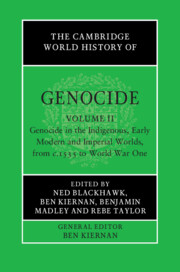Book contents
- The Cambridge World History of Genocide
- The Cambridge World History of Genocide
- The Cambridge World History of Genocide
- Copyright page
- Contents
- Figures
- Maps
- Tables
- Contributors to Volume ii
- Introduction to Volume ii
- Part I Settler Colonialism
- Part II Empire-Building and State Domination
- Part III Nineteenth-Century Frontier Genocides
- Part IV Premonitions
- 22 Genocide and the Forcible Removal of Aboriginal Children in Australia, 1800–1920
- 23 The Killing Fields of Jiangnan
- 24 The Crime of the Congo
- 25 The Ottoman Massacres of Armenians, 1894–1896 and 1909
- 26 ‘Rivers of Blood and Rivers of Money’
- 27 Representations of the Poison Gas War on the Eastern Front, 1915–1917
- Index
22 - Genocide and the Forcible Removal of Aboriginal Children in Australia, 1800–1920
from Part IV - Premonitions
Published online by Cambridge University Press: 23 June 2023
- The Cambridge World History of Genocide
- The Cambridge World History of Genocide
- The Cambridge World History of Genocide
- Copyright page
- Contents
- Figures
- Maps
- Tables
- Contributors to Volume ii
- Introduction to Volume ii
- Part I Settler Colonialism
- Part II Empire-Building and State Domination
- Part III Nineteenth-Century Frontier Genocides
- Part IV Premonitions
- 22 Genocide and the Forcible Removal of Aboriginal Children in Australia, 1800–1920
- 23 The Killing Fields of Jiangnan
- 24 The Crime of the Congo
- 25 The Ottoman Massacres of Armenians, 1894–1896 and 1909
- 26 ‘Rivers of Blood and Rivers of Money’
- 27 Representations of the Poison Gas War on the Eastern Front, 1915–1917
- Index
Summary
The literature on Australia’s Stolen Generations and genocide has focused on the twentieth century but forcible child removal was integral to colonization from its beginning in in 1788. This historical analysis chronicles the abuse and deaths of stolen children at colonists’ hands during the nineteenth century through the rubric of the United Nations Convention on Genocide in 1948. This is a history of private kidnapping along spreading frontiers, sanctioned by colonial authorities, and government projects for “Christianizing and civilizing” the children in isolated missions. Both reasons for removing children provided labor for colonists and cleared Aboriginal families from their lands. Despite critics in Britain and the colonies and opposition from Aboriginal families these practices continued into the twentieth century and contributed to the foundations of the modern “Stolen Generations”. The Australian Federal Constitution (1901) left Aboriginal people under the control of state governments. New laws extinguishing citizenship and economic independence increased family poverty and vulnerability of all Aboriginal people, including those of ‘mixed’ descent. Forcible removals to draconian institutions and menial labor for life became normalized for many children until the mid-twentieth century. The enormity of these crimes committed against Aboriginal children and their kin prompts the question, what restorative effects the Genocide Convention might offer their descendants? This chapter traces this history, focusing on the colonies of New South Wales, Van Diemen's Land (Tasmania), Queensland, Victoria and Western Australia.
Keywords
- Type
- Chapter
- Information
- The Cambridge World History of Genocide , pp. 537 - 561Publisher: Cambridge University PressPrint publication year: 2023



